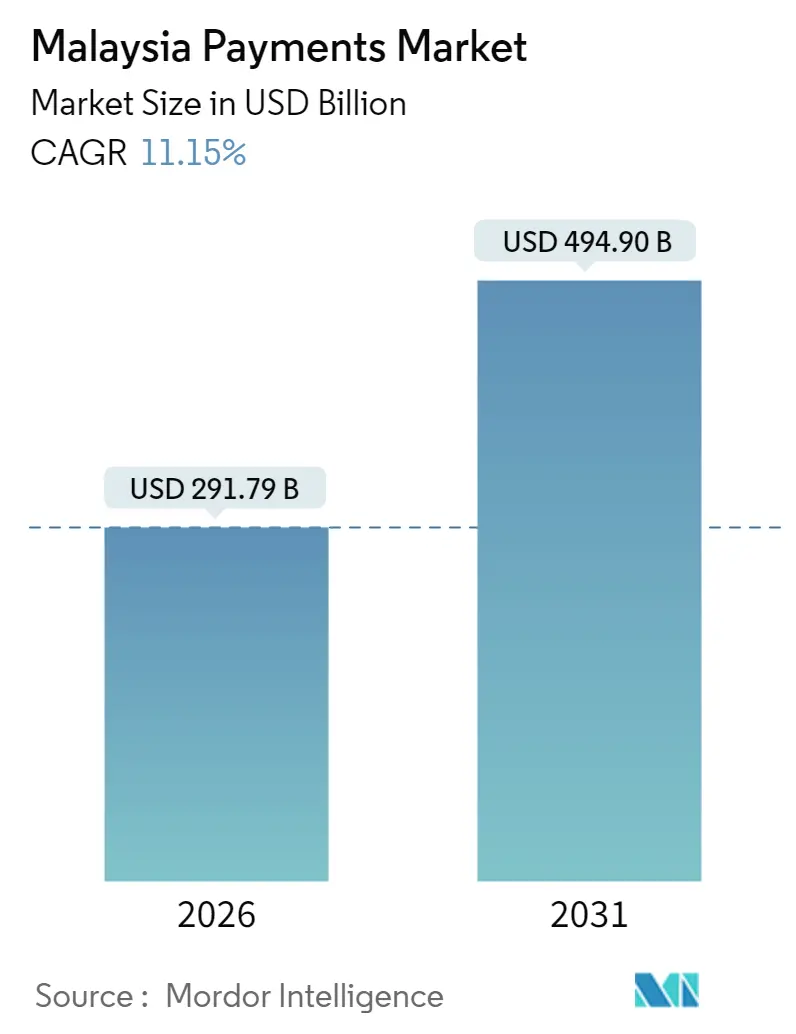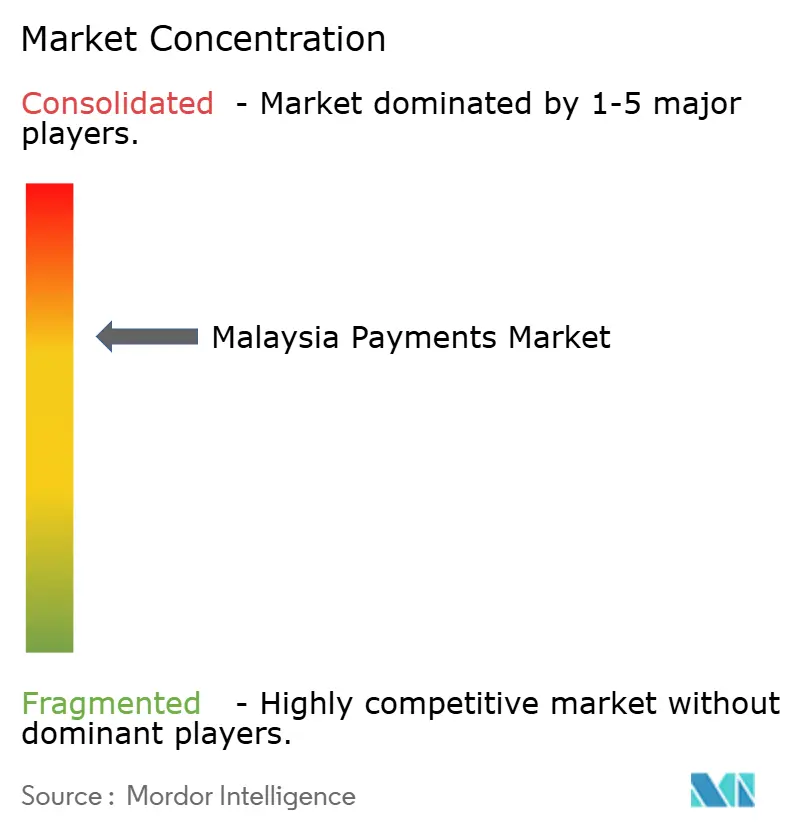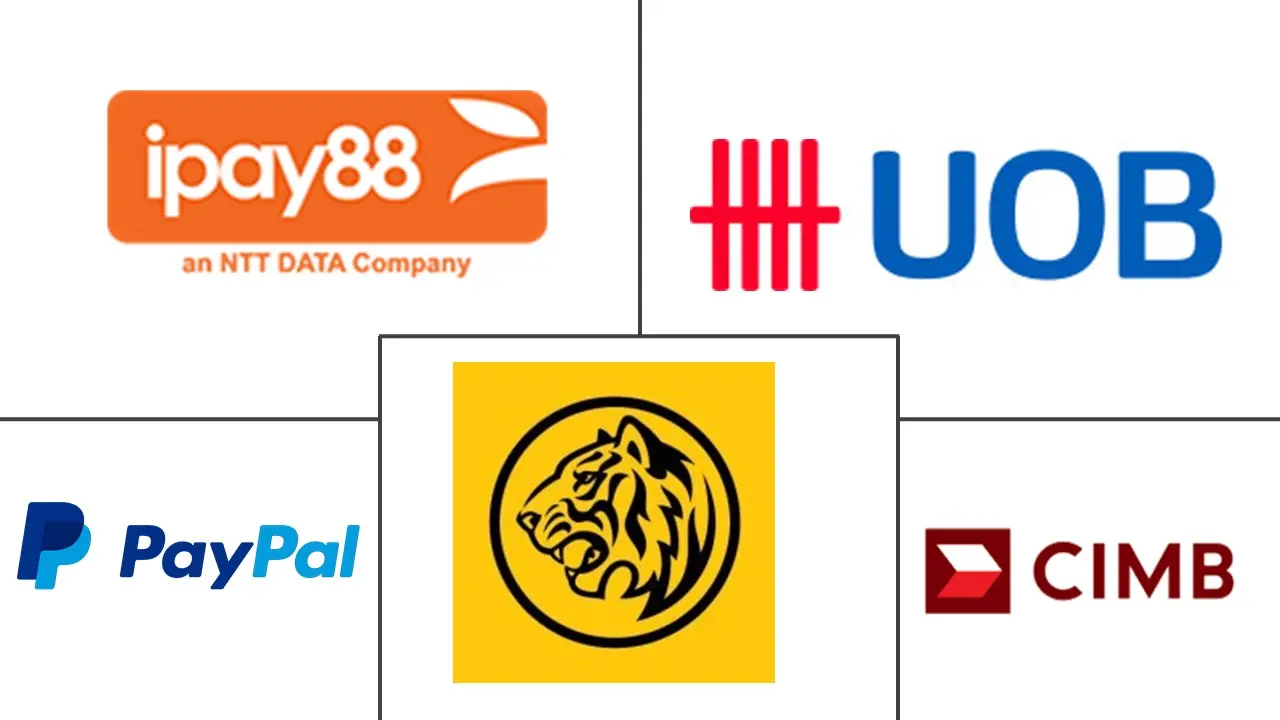
Malaysia Payments Market Analysis by Mordor Intelligence
Malaysia payments market size in 2026 is estimated at USD 291.79 billion, growing from 2025 value of USD 262.5 billion with 2031 projections showing USD 494.9 billion, growing at 11.15% CAGR over 2026-2031. The upward curve is anchored in the government’s interoperable QR strategy, a real-time rails network that underpins instant transfers, and aggressive cashless incentives targeted at rural micro-merchants.[1]Bank Negara Malaysia, “Digital Payments and Financial Inclusion,” BNM.gov.my Continuous e-commerce expansion, 88% urban e-wallet penetration, and the rise of Islamic fintech propositions together create reinforcing feedback that keeps digital volumes on a double-digit trajectory. Account-to-account (A2A) rails, already embedded in popular super-apps, draw incremental traffic from Malaysia’s gig workforce that demands nightly payouts while cross-border corridors funnel inbound tourist spending over shared QR infrastructure. Incumbent card schemes retain relevance in high-ticket online purchases, yet their strongest growth stems from tokenized credentials that ride on contactless point-of-sale terminals now blanketing Klang Valley hypermarkets. Cyber-security remains a capex priority as QR scam sophistication rises, but the National Fraud Portal’s coordinated response is beginning to close authentication gaps in banking apps.
Key Report Takeaways
- By mode of payment, digital wallets led with 35.10% share of the Malaysia payments market in 2025; A2A payments are advancing at a 12.02% CAGR through 2031.
- By end-user industry, retail held 28.25% of the Malaysia payments market share in 2025, while transport and logistics is racing ahead at an 11.72% CAGR to 2031.
Note: Market size and forecast figures in this report are generated using Mordor Intelligence’s proprietary estimation framework, updated with the latest available data and insights as of January 2026.
Malaysia Payments Market Trends and Insights
Drivers Impact Analysis
| Driver | (~) % Impact on CAGR Forecast | Geographic Relevance | Impact Timeline |
|---|---|---|---|
| Rapid e-commerce expansion and mobile-shopping adoption | +2.1% | National, with concentration in Klang Valley and Johor | Short term (≤ 2 years) |
| Government push for interoperable QR (DuitNow) and contactless cards | +1.8% | National, with rural expansion focus | Medium term (2-4 years) |
| Contactless card penetration and NFC terminal rollout | +1.5% | Urban centers, expanding to suburban areas | Medium term (2-4 years) |
| Rise of Islamic fintech and Sharia-compliant payment propositions | +1.2% | National, with spillover to ASEAN Muslim markets | Long term (≥ 4 years) |
| ASEAN cross-border e-wallet interoperability initiatives | +0.9% | Border regions, tourist destinations, business hubs | Long term (≥ 4 years) |
| Instant payouts for gig-economy via real-time rails | +0.7% | Urban centers with high gig-worker concentration | Short term (≤ 2 years) |
| Source: Mordor Intelligence | |||
Government Push for Interoperable QR and Contactless Cards
DuitNow’s nationwide QR standard now spans 80 million Alipay-enabled merchants, with bilateral links active in Indonesia, Singapore, Thailand, and Cambodia. Bank Negara Malaysia mandates a single merchant display QR, shrinking terminal clutter and onboarding costs for micro-enterprises. By May 2025, rural wet-market stalls across Perak and Kelantan accepted contactless payments, reflecting targeted subsidy programs for NFC terminals. Cross-border transaction limits rose sharply after the People’s Bank of China lifted caps to USD 5,000 per scan, allowing Touch ’n Go users to execute higher-value purchases during outbound tourism peaks.[2]Wong Alexander, “TNG eWallet Users Can Pay RM20,000 in a Single QR Transaction in China,” MalayMail.com Merchants gain through a single integration that auto-routes transactions to the cheapest rail, improving margins and accelerating digital penetration into cash-heavy districts.
Rapid E-commerce Expansion and Mobile-Shopping Adoption
Malaysia’s online retail GMV jumped amid social-commerce live selling and free-shipping campaigns that funnel more cart checkouts toward stored-value wallets. ShopeePay and Touch ’n Go’s direct embedding into Google Pay’s autofill layer strips out manual card entry, lifting mobile conversion rates for F&B and pharmacy merchants. An 88% e-wallet adoption rate in 2024 signals a tipping point where digital checkout is now default for discretionary spend. E-commerce platforms extend into grocery and on-demand services, illustrated by Grab’s Jaya Grocer acquisition that brings high-frequency fresh-food baskets onto its wallet rail. The shift also accelerates buy-now-pay-later (BNPL) uptake as BigPay Later enters the licensed online moneylender pool, offering installment options to first-jobbers traditionally underserved by credit cards.
Rise of Islamic Fintech and Sharia-Compliant Payment Propositions
AEON Bank’s 2024 debut as Malaysia’s first Islamic digital bank crystallizes years of regulatory sandbox work that balanced Shariah governance with open-API design. SeaMoney soon followed with murabaha-based micro-financing, demonstrating commercial appetite for religiously aligned credit. BIMB Holdings in 2025 began white-labeling biometric e-KYC modules for smaller rural Islamic co-operatives, lowering onboarding costs while meeting fatwa standards on data privacy. Malaysia’s positioning attracts intra-ASEAN Muslim tourist flows who prefer wallets carrying halal certification, helping the Malaysia payments market capture incremental cross-border volume from Indonesia and Brunei. Premium pricing is viable because consumers perceive higher trust in Shariah screening, allowing providers to wrap ethical investing and takaful micro-insurance around the payment core.
ASEAN Cross-Border E-Wallet Interoperability Initiatives
Project Nexus prototypes multilateral clearing that connects DuitNow, Singapore’s PayNow, Thailand’s PromptPay and Indonesia’s QRIS into a single lookup alias for phone-number transfers. The PayNow-DuitNow linkage already records sub-15-second settlements, giving SMEs certainty on cash flow when paying suppliers across the Johor-Singapore corridor. Touch ’n Go’s 1% FX markup, introduced in April 2024, has been accepted by users who value transparent rates and instant confirmations. UOB Infinity’s launch in April 2025 brings corporate dashboard visibility, letting exporters trace incoming Thai baht payments in real time. As corridors proliferate, Malaysia cements its role as a payment gateway for supply chains spanning ASEAN’s 680 million-strong consumer base, reinforcing network effects in the Malaysia payments market.
Restraints Impact Analysis
| Restraint | (~) % Impact on CAGR Forecast | Geographic Relevance | Impact Timeline |
|---|---|---|---|
| Persistent cash preference among SMEs and rural consumers | -1.4% | Rural areas, traditional wet markets, suburban SME clusters | Medium term (2-4 years) |
| Rising fraud and cybersecurity concerns lowering trust | -0.8% | National, with higher impact in urban digital-first segments | Short term (≤ 2 years) |
| Fragmented acquiring market keeps MDR high for micro-merchants | -0.6% | National, concentrated in micro-merchant segments | Medium term (2-4 years) |
| e-KYC hurdles for migrant and foreign workers | -0.4% | Industrial areas, construction zones, plantation regions | Short term (≤ 2 years) |
| Source: Mordor Intelligence | |||
Persistent Cash Preference Among SMEs and Rural Consumers
Seventy-seven percent of SMEs remain at basic digital maturity, citing MDR fees and unreliable cellular coverage as barriers to adopting QR codes.[3]Malaysian SME Corp., “SME Digitalization Report,” SMECorp.gov.my In Sabah and Sarawak, vendors at pasar tani still settle mostly in cash because float management is simpler than reconciling daily e-wallet payouts. Fragmented acquiring keeps merchant rates above 2% for micro-tickets, eroding slim produce margins and reinforcing cash loyalty. Government voucher schemes improved uptake during festive seasons yet many hawkers revert to cash once subsidies lapse. As a result, two parallel systems persist, slowing the Malaysia payments market penetration curve outside urban clusters.
Rising Fraud and Cybersecurity Concerns Lowering Trust
QR phishing rings exploited fake donation drives in late 2024, pushing Bank Negara Malaysia to tighten e-KYC requirements in April 2024. The National Fraud Portal launched an always-on hotline and a centralized mule-account blacklist that banks query before payout.[4]National Fraud Portal, “Fraud Prevention and Reporting,” Fraud.gov.my Additional authentication steps, such as selfie-liveness checks, raise user onboarding time, prompting some low-tech consumers to revert to cash. The iPay88 breach reinforced SME fears, leading marketplaces to mandate tokenized payment vaults that elevate compliance costs. Providers now allocate rising opex to AI-based anomaly detection, a burden that small PSPs struggle to absorb, tempering competitive entry in the Malaysia payments market.
Segment Analysis
By Mode of Payment: Digital Wallets Lead, A2A Payments Accelerate
Digital wallets held 35.10% of the Malaysia payments market share in 2025, translating to a USD 92.14 billion slice of total transaction value. The Malaysia payments market size for wallets is forecast to expand at an 11.15% CAGR in lockstep with smartphone penetration gains. A2A payments, riding on DuitNow instant rails, post the fastest growth at 12.02% CAGR, pulling salary disbursements for 1.5 million gig workers into near-instant clearing cycles. Card rails remain sticky in high-ticket airline and electronics segments due to chargeback protection, yet continuous issuance of contactless MyDebit cards shifts small-value rides on mass transit away from tokens. Cash-on-delivery’s relevance is falling as rural logistics networks now accept parcel locker QR settlement, cutting driver float losses. BNPL volumes, though from a small base, climbed 40% in 2024 after BigPay Later acquired an online moneylender license, signaling regulator comfort with installment credit embedded in wallet flows.
Second-generation wallets embed closed-loop loyalty, overseas roaming via Alipay+ and micro-investment modules, keeping users inside a single super-app. GrabPay’s API partnership with PayPal extends acceptance into global marketplaces while retaining local MDR economics under the PayNet interchange cap. Competitive differentiation now tilts to fraud-rate performance and gig payout latency, areas where legacy banks invest in faster-payments “overlay services” to retain deposit flow. A2A providers push Request-to-Pay functionality that lets merchants sidestep QR stickers and pop invoices directly into consumer banking apps, signaling the next wave of wallet-rails cannibalization.

Note: Segment shares of all individual segments available upon report purchase
By End-User Industry: Retail Dominance, Transport and Logistics Surge
Retail commanded USD 74.16 billion flow in 2025, securing 28.25% Malaysia payments market share as supermarket chains mandated contactless lanes to shorten checkout queues. The Malaysia payments market size for retail is projected to grow at 9.95% through 2031, buoyed by scan-and-go pilots that offload basket scanning to consumers. Transport and logistics, however, is the fastest-expanding vertical at an 11.72% CAGR as ride-hailing platforms migrate driver incentives from weekly bulk payouts to on-demand wallet transfers. Grab’s acquisition of Jaya Grocer adds grocery last-mile and unlocks same-day fulfillment, causing a step-change in transaction frequency per user. Parcel lockers connected to DuitNow QR enable couriers to collect COD equivalents digitally, reducing cash pilferage.
Entertainment and hospitality rebound post-pandemic sees venues integrating table-top QR ordering that routes payment directly to kitchen screens, shrinking service staff overhead. Private healthcare accelerates self-service kiosk check-ins with embedded FPX bank transfer, although public hospitals lag due to legacy ERP constraints. Education payments digitalize via Ministry of Education’s cashless campus initiative, but adoption varies by rural school bandwidth. Government e-invoicing mandates kicking in from August 2025 will standardize digital payable workflows, nudging even cash-dependent wholesalers to adopt e-collection modules.

Note: Segment shares of all individual segments available upon report purchase
Geography Analysis
Greater Klang Valley alone accounts for nearly half of Malaysia payments market transaction volume, reflecting dense retail clusters and 98% 4G coverage that underpins always-on wallet connectivity. Johor’s proximity to Singapore amplifies cross-border flows as commuters embrace PayNow-DuitNow for daily toll and food purchases, registering the highest regional CAGR at 12.75%. Penang leverages its electronics export ecosystem and tourism draw to sustain double-digit wallet growth, with hawker centers now displaying unified QR stands funded by state innovation grants. Northern Kedah and Perlis lag in adoption due to smaller merchant bases but improve yearly as agro-cooperatives receive NFC terminal subsidies.
East Malaysia exhibits mixed progress; Sarawak’s urban centers like Kuching record solid contactless uptake, yet interior settlements remain cash-centric because patchy grid power limits POS uptime. Sabah’s tourist islands adopted Alipay+ acceptance, letting Chinese travelers spend seamlessly via yuan-denominated wallets, boosting island retail receipts. Border districts with Thailand participate in PromptPay connectivity, fueling duty-free mall sales settled in ringgit without card FX fees. Rural Perak sees rising smartphone-based credit scoring via Shariah micro-financiers, adding fresh wallet users in palm-oil estates.
National digital inclusion programs accelerate tower upgrades along Federal Route 1, helping school canteens in Negeri Sembilan pilot QR-only transactions. Federal civil service salary switch to DuitNow for expense claims drives wallet penetration further outside major metros. With nearly 30 million smart devices now active, every geography is on an upward but uneven path, collectively expanding the Malaysia payments market footprint.
Competitive Landscape
Malaysia’s payments market shows moderate concentration: the top five players, Maybank, CIMB, Touch ’n Go, GrabPay and Boost, collectively controlled an estimated 63% value share in 2024. Maybank leverages 11 million MAE app users and bank-grade fraud analytics to keep churn low while partnering with PayNet for open-loop QR acceptance. CIMB deepens SME stickiness via e-invoice-ready POS bundles that merge PayNet rails with bookkeeping, shrinking reconciliation time for traders. Touch ’n Go’s wallet ubiquity on toll roads translates into first-mover strength at physical retail; its April 2024 cross-border FX fee aligned economics with regional peers. GrabPay integrates ride, food and fintech services, reinforcing ecosystem lock-in and generating high transaction velocity per user.
International schemes maintain relevance. Visa pilots Click-to-Pay tokenization with BSN to slash e-commerce checkout fields, buoying card approval rates. Mastercard’s Instapay deal channels migrant worker wages into prepaid cards, fulfilling central bank KYC directives while capturing a new flow lane. UnionPay QR’s January 2025 entry through BSN aims at tech-savvy consumers traveling to Mainland China, nudging competitive pricing on MDRs. Smaller PSPs focus on specialty verticals, GHL on BNPL for F&B and iPay88 on subscription billing, but face scalability challenges as fraud-mitigation costs climb.
Strategic moves concentrate on ecosystem expansion. Capital A plans to divest BigPay majority holding to fund airline rebound while retaining wallet data synergies. PayPal’s global open-platform roadmap promises Malaysian merchants omnichannel SDKs that wrap BNPL, crypto checkout and pay-by-bank options. UOB Infinity launches a dashboard for cross-border settlement tracking, courting mid-cap exporters who demand real-time visibility over ASEAN receivables. Competition gravitates toward holistic service bundles, payments plus credit, insurance, HR and analytics, blurring the lines between bank, wallet and technology provider in the Malaysia payments market.
Malaysia Payments Industry Leaders
-
Ipay88 (m) Sdn Bhd
-
United overseas bank (Malaysia) Bhd
-
Malayan Banking Berhad (Maybank)
-
CIMB Group Holdings Berhad
-
PayPal Holdings, Inc.
- *Disclaimer: Major Players sorted in no particular order

Recent Industry Developments
- May 2025: AirAsia MOVE launched BigPay Lite, an embedded wallet enabling in-app account creation and payments without separate app downloads, featuring exclusive discounts and early access to sales events Malaysian Business.
- April 2025: Google Pay integrated ShopeePay and Touch ’n Go eWallet for Android users in Malaysia, enabling seamless checkout experiences through mobile Chrome with initial merchant rollout including Nando’s, US Pizza and Alpro Pharmacy The Paypers.
- April 2025: UOB Malaysia introduced UOB Infinity, a real-time cross-border payment tracking platform providing corporate clients with instant notifications, transparent fee visibility and multi-market cash flow management The Edge Malaysia.
- April 2025: Capital A announced plans to sell a majority stake in BigPay to an undisclosed regional bank while retaining approximately 30% ownership, with BigPay serving over 1.6 million cardholders as of end-2024 The Edge Malaysia.
Malaysia Payments Market Report Scope
Payment shall be a voluntary transfer of funds, equivalent, or other valuable items from one person to another in exchange for goods and services received or satisfying an obligation under the law.
The Malaysian Payments Market is segmented by mode of payment (point of sale (card payments, digital wallets (including mobile wallets), cash) and online sale (card payments, digital wallets)) and end-user industry (retail, entertainment, healthcare, and hospitality).
The market sizes and forecasts are provided in terms of value (USD) for all the above segments.
| Point of Sale | Debit Card Payments |
| Credit Card Payments | |
| Account-to-Account (A2A) Payments | |
| Digital Wallet | |
| Cash | |
| Other Point of Sale Payment Modes | |
| Online Sale | Debit Card Payments |
| Credit Card Payments | |
| Account-to-Account (A2A) Payments | |
| Digital Wallet | |
| Cash-on-Delivery | |
| Other Online Sales Payment Modes |
| Retail |
| Entertainment |
| Hospitality |
| Healthcare |
| Transport and Logistics |
| Other End-User Industries |
| By Mode of Payment | Point of Sale | Debit Card Payments |
| Credit Card Payments | ||
| Account-to-Account (A2A) Payments | ||
| Digital Wallet | ||
| Cash | ||
| Other Point of Sale Payment Modes | ||
| Online Sale | Debit Card Payments | |
| Credit Card Payments | ||
| Account-to-Account (A2A) Payments | ||
| Digital Wallet | ||
| Cash-on-Delivery | ||
| Other Online Sales Payment Modes | ||
| By End-User Industry | Retail | |
| Entertainment | ||
| Hospitality | ||
| Healthcare | ||
| Transport and Logistics | ||
| Other End-User Industries | ||
Key Questions Answered in the Report
How large is the Malaysia payments market in 2026?
The market processed USD 291.79 billion in transaction value in 2026 and is tracking an 11.15% CAGR toward 2031.
Which payment mode leads consumer transactions nationwide?
Digital wallets dominate with a 35.10% share, led by Touch ’n Go and GrabPay users in everyday spending.
Which segment is growing fastest within Malaysia’s payment ecosystem?
Account-to-account transfers are expanding at a 12.02% CAGR as real-time rails fulfil instant payout needs.
What vertical records the strongest growth?
Transport and logistics transactions are set for an 11.72% CAGR on the back of ride-hailing and automated settlement platforms.
How do cross-border QR links benefit Malaysia?
Interoperability with Singapore, Thailand, Indonesia and China removes FX friction, driving tourist and SME transaction uplift across shared rails.
Page last updated on:



